Usability is critical for the success of any website or web application. To make sure your web-based project is bug-free, you need to run UI tests, many of which can—and should—be automated. Doing so lets you detect issues like bugs, slow loading times, or poor responsiveness so you can fix them before they make a bad impression on users. But while you can find a lot of UI testing tools online, this abundance of options makes it challenging to choose the right UI tool for your project.
To help you with this, we’ll show you the seven best UI automation testing tools and give you pointers for how to choose the best one for your QA testing process.
Table of Contents
- What is UI testing?
- The Best UI Testing Tools
- How to choose the right UI testing tool for you
- Conclusion
Automate your UI testing workflow
with Ghost Inspector
Our 14 day free trial gives you and your team full access. Create tests in minutes. No credit card required.
What Is UI Testing?
UI stands for User Interface, which is the part of a website or application that users see and interact with. UI testing can also be referred to as GUI testing, or graphical user interface testing. The UI includes various elements such as the visuals, icons, buttons, sliders, text fields, dropdown lists, etc.
The quality of the UI has a huge impact on whether users will use your site or app at all. If the UI of a site or app is unintuitive, confusing, or filled with bugs, users will leave and go elsewhere. In fact, 88% of online consumers are less likely to return after a bad experience. So you need to know if your site or app is always working properly from the user’s point of view.
This is where UI testing comes in. It’s the process of testing whether a website or web app is user-friendly and working as intended. You want users to easily understand how they can do what they want and do it without running into issues. So the goal of UI testing is to ensure your website is displayed and running properly on most if not all operating systems and web browsers.
Testers can write and run tests manually, but this can become too time-consuming and costly, so they often turn to UI testing tools. A UI testing tool is a software solution that runs a script which checks how a site or app is displayed and replicates common actions taken by users, like logging in or placing an order, to validate the functionality of that web platform.
Now that you know how important automated UI testing can be, it’s time to dive into the six best UI testing tools for testing automation.
The Best UI Testing Tools
1. Ghost Inspector
Ghost inspector is a no-code tool for end-to-end automated UI testing. You can use it to create browser tests for websites and web apps with minimal effort. Anyone in your company can use Ghost Inspector to run automated tests on Chrome and Firefox, which means that QA can (finally!) be democratized.
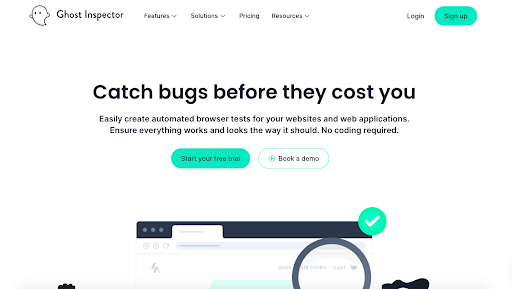
With Ghost Inspector, you and your team can create, run, record, store, and manage automated tests. As a result, developers and QA engineers can focus their time and energy on more complex tests as well as other important projects.
Ghost Inspector is very simple to use. Basically, you record a video of yourself performing any user interaction on your website, and Ghost Inspector turns it into a reproducible test. From there, you specify assertions to confirm everything is working properly and run your automated test. For every test, you review the results and get a notification whenever a failure occurs so your team can look into it. Furthermore, you can schedule automated tests to continuously monitor the functionality of your website.
GHOST INSPECTOR HIGHLIGHTS
Ghost Inspector is a powerful tool, packed with a wide range of features that cover pretty much all UI testing needs:
- Very easy to set up and use for a non-technical person.
- Codeless test automation.
- Cross-browser testing: test your web project across different browsers.
- Visual testing: Check your site or app for accessibility.
- Regression testing: Confirm that feature updates won’t cause software issues or visual regressions on your website or app.
- Parallel testing: unlike some other UI test tools, you don’t have to pay more to run multiple tests simultaneously. Save time and money with parallel test execution.
- Geolocation testing: test your site from 16 regions across the globe.
- Responsiveness testing.
- Accessibility testing: check any page or screen for accessibility.
- Advanced features: developers who are experienced with Selenium or Cypress can write tests for more complex scenarios, like iFrames, 2FA Logins, emails sent by your app, etc.
- Store your tests in different versions.
- Integrations with platforms like GitHub, Jenkins, Slack, Jira, etc.
- Plugins and API for extra flexibility.
You can try Ghost Inspector for free and upgrade later to one of three paid plans: Small ($109/month), Medium ($225/month), and Large ($449/month). The Small Plan allows for 10,000 tests run monthly, 5 users, and a result retention period of 6 months. There is also an Enterprise level with a custom offer and pricing.
Watch an On-Demand Demo:
Please refer to our Privacy Policy for more information
about the data we collect and manage.
Automate your UI testing workflow with Ghost Inspector
Our 14 day free trial gives you and your team full access. Create tests in minutes. No credit card required.
2. Selenium
There are many similarities between Ghost Inspector and Selenium – in fact, you can use Selenium alongside Ghost Inspector for your user interface testing.
Selenium is a very popular open-source web automation platform and one of the oldest. With Selenium, you can build automated UI tests for different browsers and platforms (both desktop and mobile devices). It also supports most of the popular programming languages, from JavaScript to C#, Python, PHP, and Ruby.
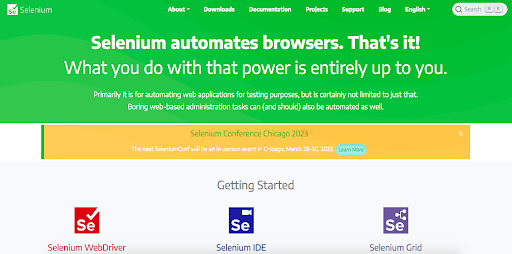
Selenium highlights
- Compatible with multiple operating systems: Windows, Mac, Linux, Unix, iOS, Android.
- Compatible with most modern browsers.
- Lots of third-party integrations: Selenium-Grid, SauceLabs, JUnit, NUnit, etc.
- Parallel testing.
- A large community: developers who use Selenium are very active and supportive of each other, so it’s likely you’ll find answers to your questions and solutions to issues encountered.
- Plenty of documentation.
- A large library of plugins and extensions.
As an open-source framework, Selenium testing is free of charge, but you will need a team of developers who are experienced with it. Creating a stable and maintainable test framework will take a lot of time and effort, not to mention expert skills in popular programming languages. Your team also needs to download a driver for each browser you want to test your website on, and set up the testing environment. So the initial cost of getting tests up and running can be rather steep, and non-technical people are excluded from this entire process.
3. Cypress
Cypress is an end-to-end UI testing tool based solely on JavaScript. It supports Chrome, Firefox, and Edge. Like Selenium, this is an open-source framework you can use for free. But there are some key differences to note; unlike Selenium, Cypress runs within the browser, and you can’t test multiple tabs at the same time.
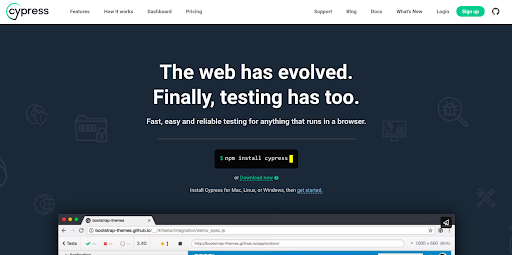
Cypress is known for its ability to check the visibility of UI elements. For example, if a button is not visible for whatever reason, the test points that out.
When it comes to browser support, Cypress works with Chrome and Chromium-based browsers (like Edge, Opera, and Brave), so you won’t be able to run tests on other browsers like Firefox and Safari. If that’s not an issue for you, Cypress does provide many advantages.
Cypress highlights
- Easy to set up and use.
- Test screenshots and video recording.
- Debugging.
- Cross-browser testing.
- Many plugins available.
- Comprehensive documentation.
- You can easily share your tests with others.
Keep in mind, though, that Cypress only supports JavaScript. It also does not support native mobile applications, so it can’t test user actions that are unique to mobile devices like swiping. Plus, you cannot run a test case on two browsers at the same time.
As we mentioned above, Cypress is entirely free and open-source. That said, you need at least a basic understanding of JavaScript to be able to use it.
4. Katalon Studio
Another popular choice for developers and QA specialists, Katalon Studio is a low-code automation tool designed on top of Selenium. You can build automated tests for websites, APIs, and desktop applications. You can also run mobile app testing on both Android and iOS.
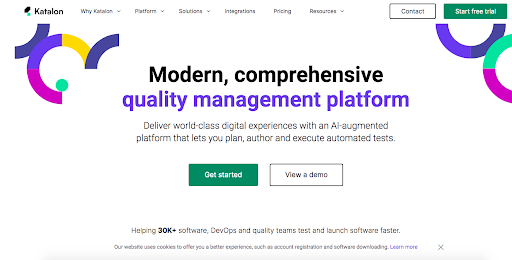
Katalon is very easy to use, thanks to its user-friendly interface. As a low-code testing tool, you don’t need expert-level programming skills, but you should know that the only language currently supported is Groovy (which is part of the Java family).
Katalon Studio highlights
- Supports most modern browsers and operating systems, for both mobile and desktop automation testing.
- Test recording, debugging, and management.
- Headless testing.
- API test automation.
- Built-in reporting feature. You can also export reports to PDF, HTML, Excel, and CSV?
- CI and CD integration
- Large number of integrations like DevOps, Gitlabs, Slack, etc.
It should be noted that while Katalon makes it possible to write and run tests without advanced programming skills, it is not a no-code UI test automation tool. Also, the Katalon community is still rather small compared to other automated UI testing tools like Selenium.
Katalon Studio has a Free Plan that allows for up to 2,000 monthly results. The Premium Plan starts at $25/month with purchasable add-ons. For large organizations, the Ultimate Plan is probably the better option, with a custom price that must be requested.
5. TestProject
TestProject is a no-code, cloud-based UI automation testing tool designed for agile teams. With TestProject, you can create automated tests for web apps (on a variety of browsers), mobile apps (on Android and iOS), and even APIs.
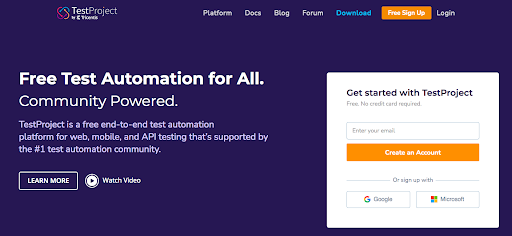
As a cloud-based solution, TestProject removes the need to download and install drivers for multiple browsers, making it quick and easy to use. Both technical and non-technical users can create tests with the Smart Test Recorder feature, and developers can use TestProject SDK to write more complex tests. TestProject supports some of the most popular scripting languages: JavaScript, C#, and Python.
TestProject highlights
- Automatic step recorder: TestProject can record you while you interact with your app and write a test script. You can then export that code to Selenium for further programming.
- Cross-browser testing.
- Execution reports: review logs and screenshots of tests to identify errors and fix them.
- Easy collaboration: share your tests, UI elements, and add-ons with your team.
- Great integrations with tools like Slack, Jenkins, QTest, etc.
- You can create addons and use existing ones.
TestProject is a free open-source tool, since it was built on top of Selenium and Appium, two open-source UI test automation tools. But while there is no upfront cost to using TestProject, it comes with a few limitations. Mainly, tests are not modular, meaning you cannot reuse a set of steps from a test to create an importable module. So whenever you want to build a new test, or you change something in your website or app, you will have to create a new test from scratch.
6. Puppeteer
Puppeteer is a Node.js library that allows you to run automated tests primarily for headless Chrome (though it is possible to configure it for non-headless Chrome). Testing with other Chromium-based browsers is doable as well. It was developed by Google and is currently maintained by the Chrome DevTools teams. So essentially, Puppeteer gives you a high-level API to control Chrome and Chromium-based browsers with the DevTools Protocol.
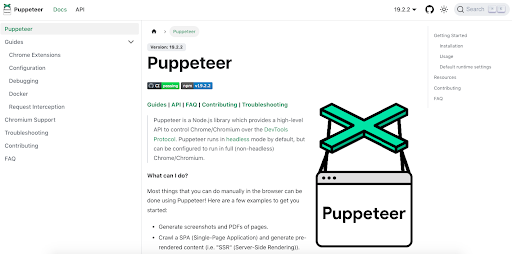
Puppeteer highlights
- Supports Windows, MacOS, and Linux.
- Supports Chrome, Chromium-based browsers, and Firefox.
- Cross-browser testing.
- Headless testing by default.
- You can take screenshots.
- You can scrape websites for data.
- Integrates with popular Continuous Integration (CI) and Agile tools.
Puppeteer supports mostly Chrome and Chromium-based browsers, so you won’t be able to use it to test your site’s UI on other browsers like Safari. That being said, Puppeteer has recently added support for Firefox even though it’s not Chromium-based.
Another thing to keep in mind is that mobile apps are not supported, so if you need to run mobile testing, you will have to look for another tool.
Lastly, Puppeteer is free since it’s open-source. You will need at least basic knowledge of JavaScript and Node.js to be able to use Puppeteer in your web projects.
7. LambdaTest
LambdaTest is another cloud-based cross-browser testing tool that allows for both manual and automated UI testing. It supports a range of programming languages, form Java to JavaScript to C#, Python, Ruby, and PHP.
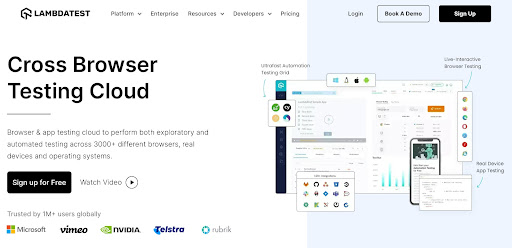
LambdaTest highlights
- Supports most browsers and operating systems (both desktop and mobile devices).
- Cross-browser testing.
- Visual testing.
- Parallel testing.
- Geolocation and responsiveness testing.
- Built-in issue tracker.
- Integrations with bug management tools and collaboration tools.
When it comes to pricing, LambdaTest has a free version you can use forever albeit with some limitations. The Live version starts at $19/month and increases in price with each additional parallel test. The Real Device version costs at least $35/month and goes up depending on the number of parallel tests you choose.
How to Choose the Right UI Testing Tool for You
As you can see from our selection, there are many solid UI testing tools. So which one should you choose? Granted, the process of identifying the right solution for your QA needs can be long and overwhelming. To make things easier for you, here are the criteria you should consider while comparing the wide range of testing options available.
Capabilities
First, you need to determine all the features you will need to run comprehensive tests. By making sure that no aspect of your UI is left untested, you will be able to fix all bugs and deliver a seamless user experience for your customers.
On top of that, you want to make sure that your tool can easily fit into your test environments, including other popular testing frameworks and collaboration platforms.
Below are questions that help you evaluate the capabilities of a given web UI testing tool:
- Does it support the popular operating systems (MacOS, iOS, Windows, etc.) and browser windows (Chrome, Firefox, etc.) ?
- Can you perform headless testing?
- Can you rest responsiveness and geolocation?
- Does the tool generate test reports? Users should find it easy to consult, understand, and share test results across your organization.
- Can you import and export tests from and to other frameworks? This flexibility is important, because your team won’t have to write tests from scratch after switching to the chosen UI testing tool.
- Can you integrate with CI/CD pipelines?
Ease of Use
For any UI testing tool that catches your eye, you should ask yourself: can a non-technical person use this tool to create and run stable tests? If not, you might run into problems down the line if you choose it.
The solution you will invest in should have an intuitive interface that anyone can understand and use. Automated tests should be easy to generate, understand, and share. So take the time to check a few tutorials videos on YouTube to get a clear idea of how user-friendly the software testing tool is.
Cost
Another essential consideration in your selection process is your budget. Depending on how much you can afford to invest and your in-house talent, the right tool for you may not be the most popular one.
Consider the ROI of a testing solution as well as the potential costs of using a tool that is inexpensive but unintuitive or lacking in features. Also, while there are free performance testing tools with potentially extensive capabilities, they often aren’t the most accessible for non-technical users and require a lot of upfront work from experienced developers. A paid solution makes more sense when you want to start running tests soon and without creating everything from scratch..
Support
Lastly, you want to know how much support is available to you. For paid solutions, the customer support team should be always ready to answer questions, address requests, and provide assistance with any issues that might arise.
In case you decide to go with a free tool, check its community beforehand to make sure there are users who provide support for each other to solve issues. If you’re stuck with something while using your UI testing tool, chances are someone else encountered the same problem. So the bigger a community is, the faster you will be able to find solutions.
Conclusion
The “quality at speed” of your product’s UI is critical to customer satisfaction. And with manual testing being often hard and time-consuming, automated testing has become a necessity. But before you select a UI testing tool, you need to evaluate your requirements and the various options available. The right choice will help you make sure the UI of your website or application is working as intended all the time. Each of the UI testing tools we discussed in this article have their advantages and drawbacks, so be sure to compare them carefully to determine which one works best for your QA needs.
If you are looking for a no-code, end-to-end, automated UI testing tool, Ghost Inspector is a standout choice. You will be able to create tests from video recordings, catch all bugs before they impact your bottom line, reuse steps from tests to quickly create new tests, and so much more. Your QA testing team will save countless hours of tedious testing and dedicate their time to other important tasks. Sign up for a free trial and get started today, or sign up below for access to a pre-recorded demo of the Ghost Inspector app in action!
Watch a Pre-Recorded Demo of Ghost Inspector
Automate your UI testing workflow
with Ghost Inspector
Our 14 day free trial gives you and your team full access. Create tests in minutes. No credit card required.


